A Methodology to Simulate LST Directional Effects Based on Parametric Models and Landscape Properties
Abstract
:1. Introduction
2. Materials
2.1. LST Data
2.1.1. Calibration Dataset
2.1.2. Evaluation Dataset
2.2. Complementary Data
3. Methods
3.1. The Parametric Models
3.2. Calibration
3.3. Surface Classification
4. Results and Discussion
4.1. Bias Correction
4.2. Analysis of the Models’ Coefficients
4.3. Assessment of Models’ Performance
4.3.1. Performance over the Calibration Database
4.3.2. Performance with an Independent Dataset
4.4. Simulation of the Angular Corrections on LST
5. Discussion
6. Conclusions
Author Contributions
Funding
Acknowledgments
Conflicts of Interest
References
- Norman, J.M.; Becker, F. Terminology in thermal infrared remote sensing of natural surfaces. Agric. For. Meteorol. 1995, 77, 153–166. [Google Scholar] [CrossRef]
- Kerr, Y.H.; Lagouarde, J.P.; Nerry, F.; Ottlé, C. Land surface temperature retrieval techniques and applications. In Thermal Remote Sensing in Land Surface Processes; CRC Press: Boston, MA, USA, 2004; pp. 33–109. [Google Scholar]
- Lagouarde, J.P.; Ballans, H.; Moreau, P.; Guyon, D.; Coraboeuf, D. Experimental study of brightness surface temperature angular variations of maritime pine (Pinus pinaster) stands. Remote Sens. Environ. 2000, 72, 17–34. [Google Scholar] [CrossRef]
- Pinheiro, A.C.T.; Privette, J.L.; Mahoney, R.; Tucker, C.J. Directional effects in a daily AVHRR land surface temperature dataset over Africa. IEEE Trans. Geosci. Remote Sens. 2004, 42, 1941–1954. [Google Scholar] [CrossRef]
- Pinheiro, A.C.T.; Privette, J.L.; Guillevic, P. Modeling the observed angular anisotropy of land surface temperature in a Savanna. IEEE Trans. Geosci. Remote Sens. 2006, 44, 1036–1047. [Google Scholar] [CrossRef]
- Barroso, C.; Trigo, I.F.; Olesen, F.; DaCamara, C.; Queluz, M.P. Intercalibration of NOAA and Meteosat window channel brightness temperatures. Int. J. Remote Sens. 2005, 26, 3717–3733. [Google Scholar] [CrossRef]
- Trigo, I.F.; Monteiro, I.T.; Olesen, F.; Kabsch, E. An assessment of remotely sensed land surface temperature. J. Geophys. Res. 2008, 113, 1–12. [Google Scholar] [CrossRef]
- Ermida, S.L.; Trigo, I.F.; Dacamara, C.C.; Göttsche, F.M.; Olesen, F.S.; Hulley, G. Validation of remotely sensed surface temperature over an oak woodland landscape—The problem of viewing and illumination geometries. Remote Sens. Environ. 2014, 148, 16–27. [Google Scholar] [CrossRef]
- Duffour, C.; Lagouarde, J.P.; Olioso, A.; Demarty, J.; Roujean, J.L. Driving factors of the directional variability of thermal infrared signal in temperate regions. Remote Sens. Environ. 2016, 177. [Google Scholar] [CrossRef]
- Duffour, C.; Olioso, A.; Demarty, J.; Van der Tol, C.; Lagouarde, J.P. An evaluation of SCOPE: A tool to simulate the directional anisotropy of satellite-measured surface temperatures. Remote Sens. Environ. 2015, 158, 362–375. [Google Scholar] [CrossRef]
- Caselles, V.; Sobrino, J.; Coll, C. A physical model for interpreting the land surface temperature obtained by remote sensors over incomplete canopies. Remote Sens. Environ. 1992, 39, 203–211. [Google Scholar] [CrossRef]
- Sobrino, J.; Caselles, V. Thermal infrared radiance model for interpreting the directional radiometric temperature of a vegetative surface. Remote Sens. Environ. 1990, 33, 193–199. [Google Scholar] [CrossRef]
- Smith, J.A.; Goltz, S.M. A thermal exitance and energy balance model for forest canopies. IEEE Trans. Geosci. Remote Sens. 1994, 32, 1060–1066. [Google Scholar] [CrossRef]
- Li, X.; Strahler, A.H. Geometric-optical bidirectional reflectance modeling of the discrete crown vegetation canopy: Effect of crown shape and mutual shadowing. Trans. Geosci. Remote Sens. 1992, 30, 276–292. [Google Scholar] [CrossRef]
- Ermida, S.L.; Trigo, I.F.; DaCamara, C.C.; Roujean, J.-L. Assessing the potential of parametric models to correct directional effects on local to global remotely sensed LST. Remote Sens. Environ. 2018, 209. [Google Scholar] [CrossRef]
- Vinnikov, K.Y.; Yu, Y.; Goldberg, M.D.; Tarpley, D.; Romanov, P.; Laszlo, I.; Chen, M. Angular anisotropy of satellite observations of land surface temperature. Geophys. Res. Lett. 2012, 39, L23802. [Google Scholar] [CrossRef]
- Ermida, S.L.; DaCamara, C.C.; Trigo, I.F.; Pires, A.C.; Ghent, D.; Remedios, J. Modelling directional effects on remotely sensed land surface temperature. Remote Sens. Environ. 2017, 190. [Google Scholar] [CrossRef]
- Lagouarde, J.P.; Irvine, M. Directional anisotropy in thermal infrared measurements over Toulouse city centre during the CAPITOUL measurement campaigns: First results. Meteorol. Atmos. Phys. 2008, 102, 173–185. [Google Scholar] [CrossRef]
- Rasmussen, M.O.; Pinheiro, A.C.; Proud, S.R.; Sandholt, I. Modeling angular dependences in land surface temperatures from the SEVIRI instrument onboard the geostationary meteosat second generation satellites. IEEE Trans. Geosci. Remote Sens. 2010, 48, 3123–3133. [Google Scholar] [CrossRef]
- Lagouarde, J.P.; Kerr, Y.H.; Brunet, Y. An experimental study of angular effects on surface temperature for various plant canopies and bare soils. Agric. For. Meteorol. 1995, 77, 167–190. [Google Scholar] [CrossRef]
- Trigo, I.F.; Dacamara, C.C.; Viterbo, P.; Roujean, J.-L.; Olesen, F.; Barroso, C.; Camacho-de-Coca, F.; Carrer, D.; Freitas, S.C.; García-Haro, J.; et al. The satellite application facility for land surface analysis. Int. J. Remote Sens. 2011, 32, 2725–2744. [Google Scholar] [CrossRef]
- Wan, Z.; Li, Z.-L. Radiance-based validation of the V5 MODIS land-surface temperature product. Int. J. Remote Sens. 2008, 29, 5373–5395. [Google Scholar] [CrossRef]
- Wan, Z.; Dozier, J. A generalized split-window algorithm for retrieving land-surface temperature from space. IEEE Trans. Geosci. Remote Sens. 1996, 34, 892–905. [Google Scholar]
- Freitas, S.C.; Trigo, I.F.; Bioucas-Dias, J.M.; Göttsche, F. Quantifying the uncertainty of land surface temperature retrievals from SEVIRI/Meteosat. IEEE Trans. Geosci. Remote Sens. 2010, 48, 523–534. [Google Scholar] [CrossRef]
- Meeus, J. Astronomical Algorithms, 2nd ed.; Willmann-Bell, Incorporated: Richmond, VA, USA, 1991; ISBN 0943396352. [Google Scholar]
- Lagarias, J.C.; Reeds, J.A.; Wright, M.H.; Wright, P.E. Convergence properties of the nelder-mead simplex method in low dimensions. SIAM J. Optim. 1998, 9, 112–147. [Google Scholar] [CrossRef]
- Seber, G.A. Multivariate Observations; Hoboken, N., Ed.; John Wiley & Sons: Hoboken, NJ, USA, 1984. [Google Scholar]
- McAtee, B.K.; Prata, A.J.; Lynch, M.J.; McAtee, B.K.; Prata, A.J.; Lynch, M.J. The angular behavior of emitted thermal infrared radiation (8–12 μm) at a semiarid site. J. Appl. Meteorol. 2003, 42, 1060–1071. [Google Scholar] [CrossRef]
- Labed, J.; Stoll, M.P. Angular variation of land surface spectral emissivity in the thermal infrared: Laboratory investigations on bare soils. Int. J. Remote Sens. 1991, 12, 2299–2310. [Google Scholar] [CrossRef]
- Ren, H.; Yan, G.; Chen, L.; Li, Z. Angular effect of MODIS emissivity products and its application to the split-window algorithm. ISPRS J. Photogramm. Remote Sens. 2011, 66, 498–507. [Google Scholar] [CrossRef]
- Sobrino, J.A.; Cuenca, J. Angular variation of thermal infrared emissivity for some natural surfaces from experimental measurements. Appl. Opt. 1999, 38, 3931–3936. [Google Scholar] [CrossRef] [PubMed]
- Li, X.; Strahler, A. Geometric-optical bidirectional reflectance modeling of a conifer forest canopy. Trans. Geosci. Remote Sens. 1986, GE-24, 906–919. [Google Scholar] [CrossRef]
- Franklin, J.; Strahler, A.H. Invertible canopy reflectance modeling of vegetation structure in semiarid woodland. IEEE Trans. Geosci. Remote Sens. 1988, 26, 809–825. [Google Scholar] [CrossRef]
- Roujean, J.-L. A parametric hot spot model for optical remote sensing application. Remote Sens. Environ. 2000, 71, 197–206. [Google Scholar] [CrossRef]
- Guillevic, P.C.; Bork-Unkelbach, A.; Göttsche, F.M.; Hulley, G.; Gastellu-Etchegorry, J.-P.; Olesen, F.S.; Privette, J.L. Directional viewing effects on satellite land surface temperature products over sparse vegetation canopies—A multisensor analysis. IEEE Geosci. Remote Sens. Lett. 2013, 10, 1464–1468. [Google Scholar] [CrossRef]
- Duffour, C.; Lagouarde, J.-P.; Roujean, J.-L. A two parameter model to simulate thermal infrared directional effects for remote sensing applications. Remote Sens. Environ. 2016, 186, 250–261. [Google Scholar] [CrossRef]
- Rasmussen, M.O.; Göttsche, F.; Olesen, F.; Sandholt, I. Directional effects on land surface temperature estimation from meteosat second generation for savanna landscapes. IEEE Trans. Geosci. Remote Sens. 2011, 49, 4458–4468. [Google Scholar] [CrossRef]
- Lagouarde, J.P.; Dayau, S.; Moreau, P.; Guyon, D. Directional anisotropy of brightness surface temperature over vineyards: Case study over the Medoc Region (SW France). IEEE Geosci. Remote Sens. Lett. 2014, 11, 574–578. [Google Scholar] [CrossRef]


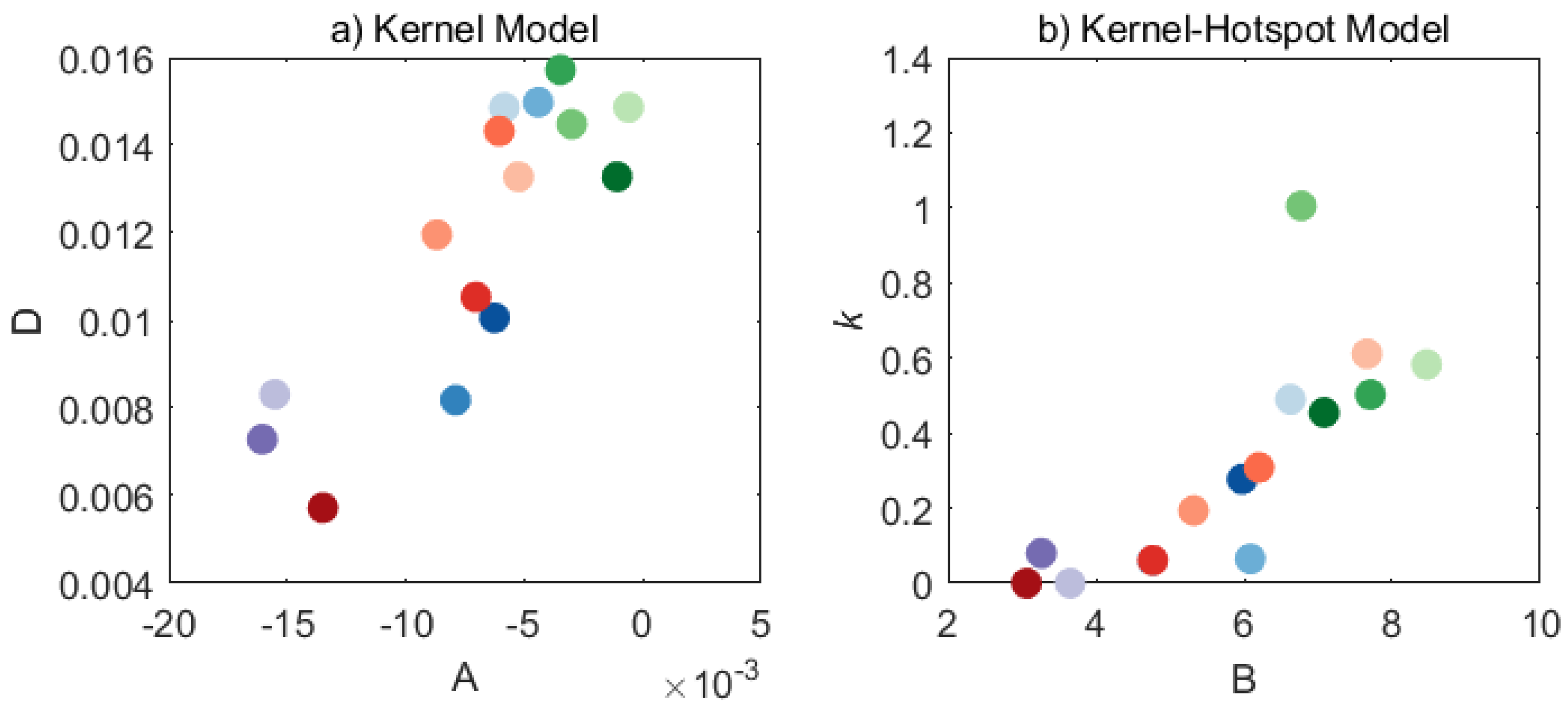
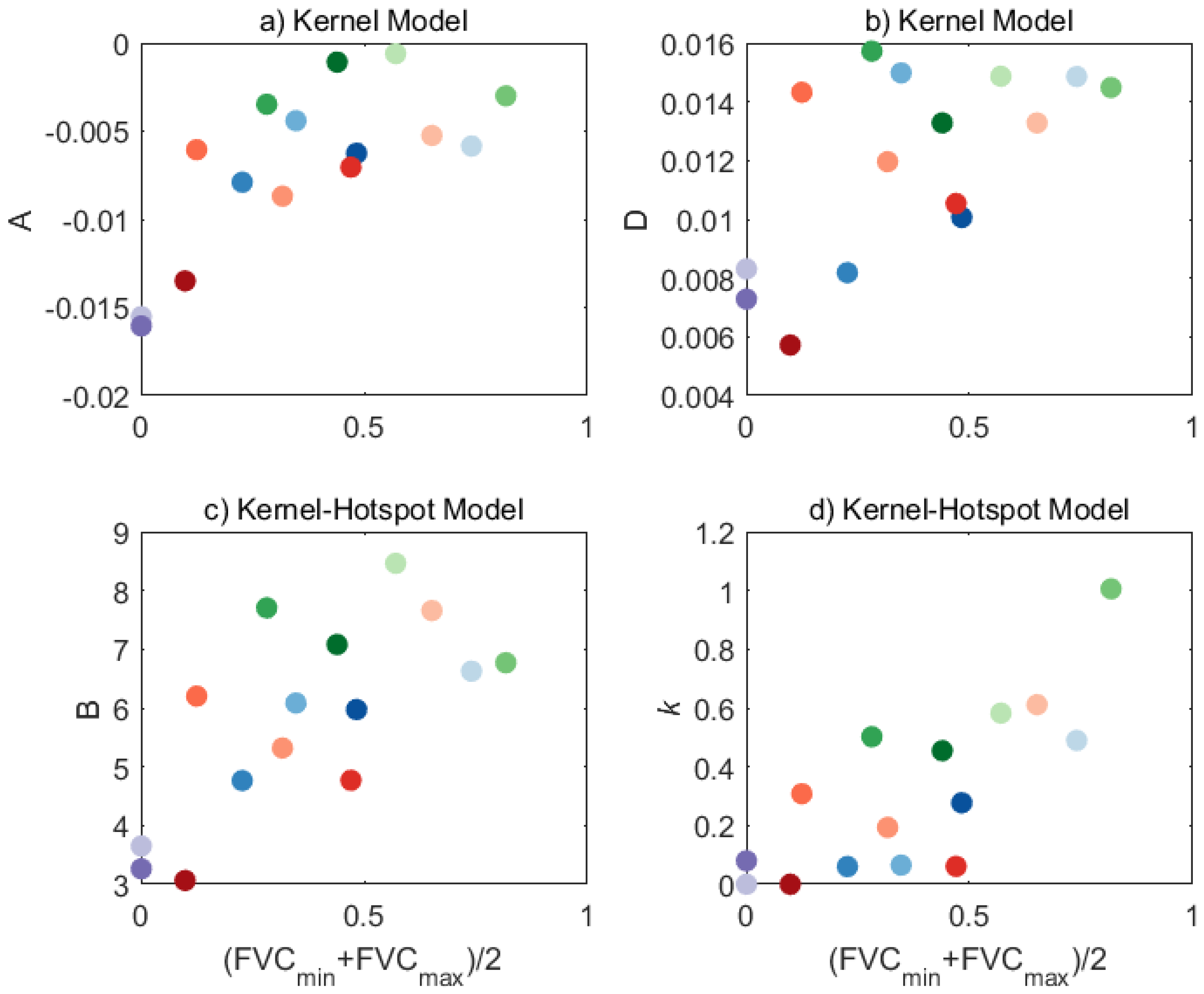
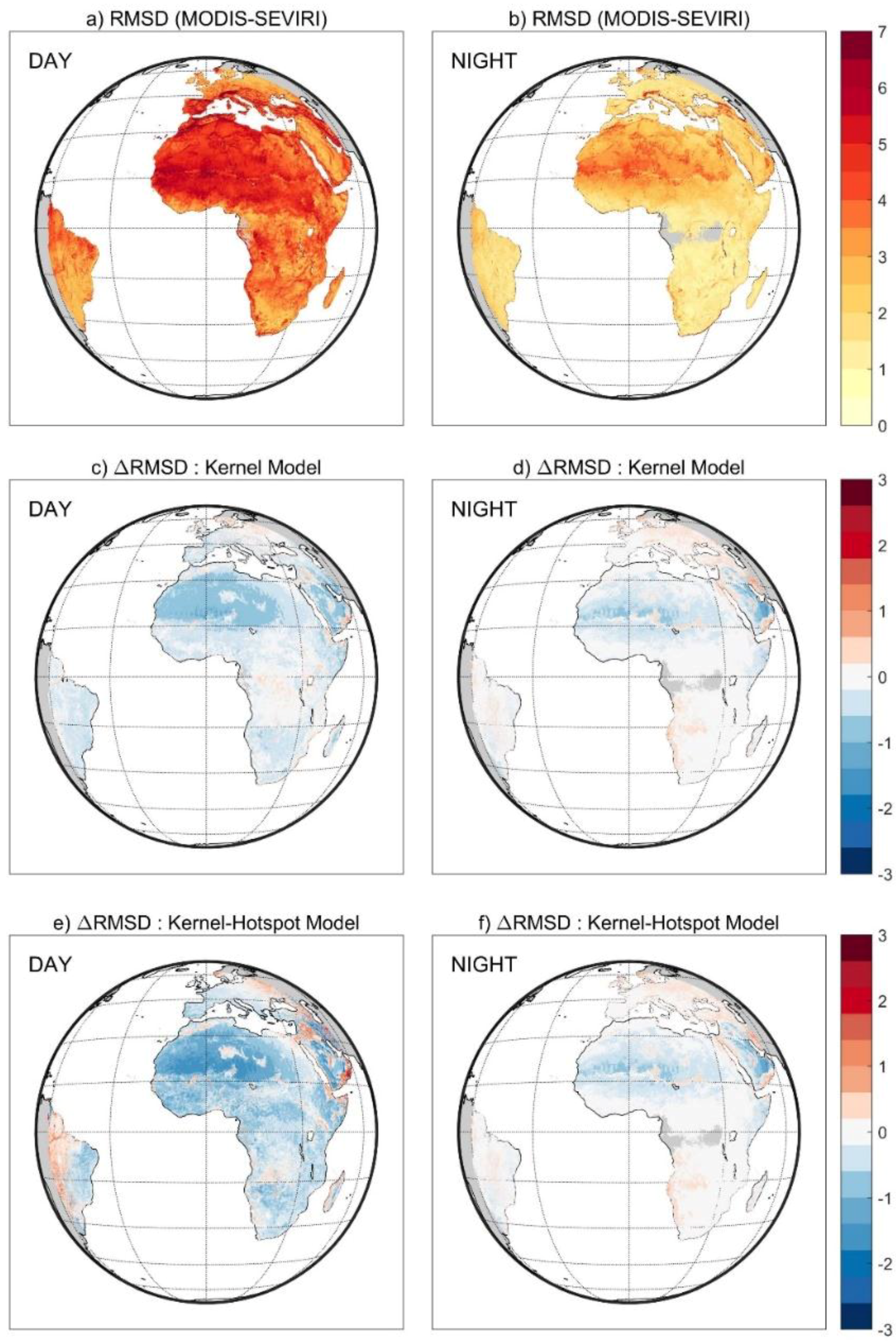
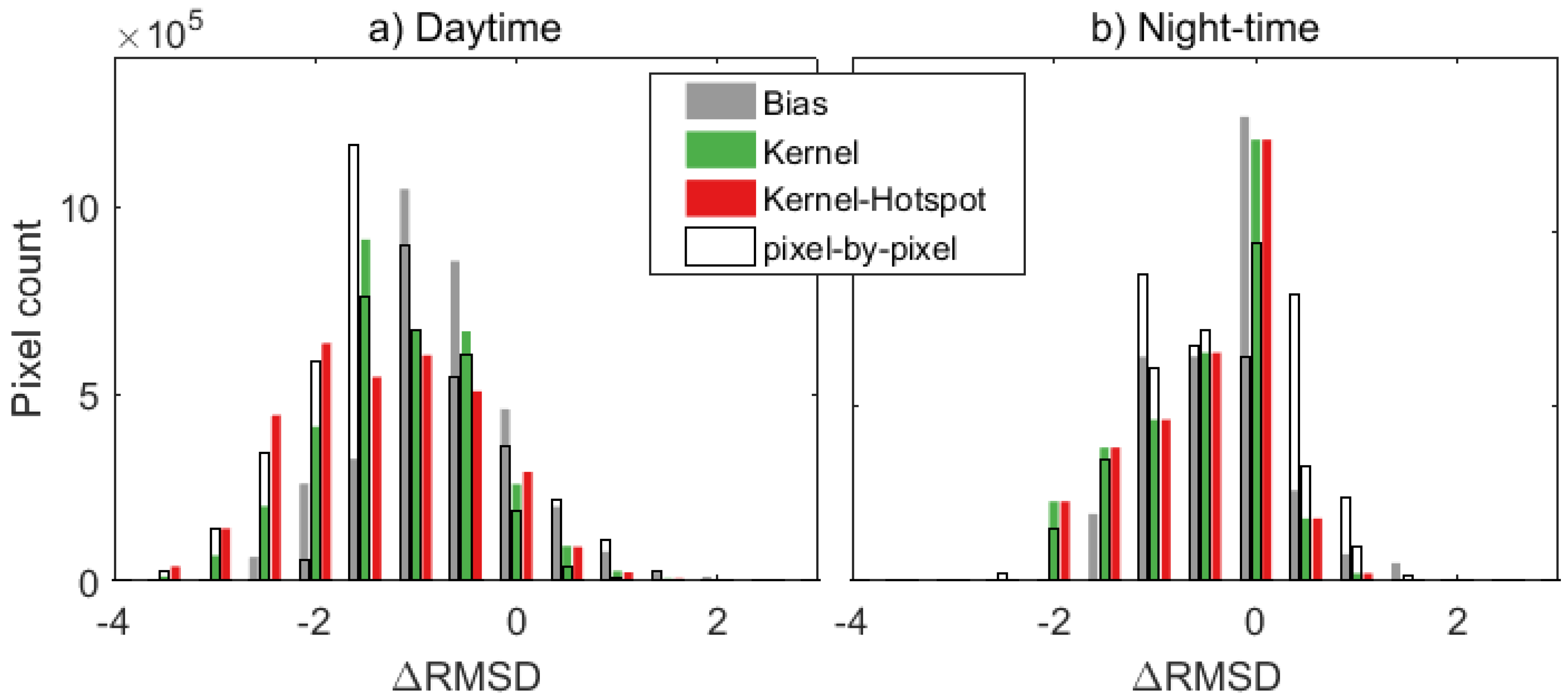
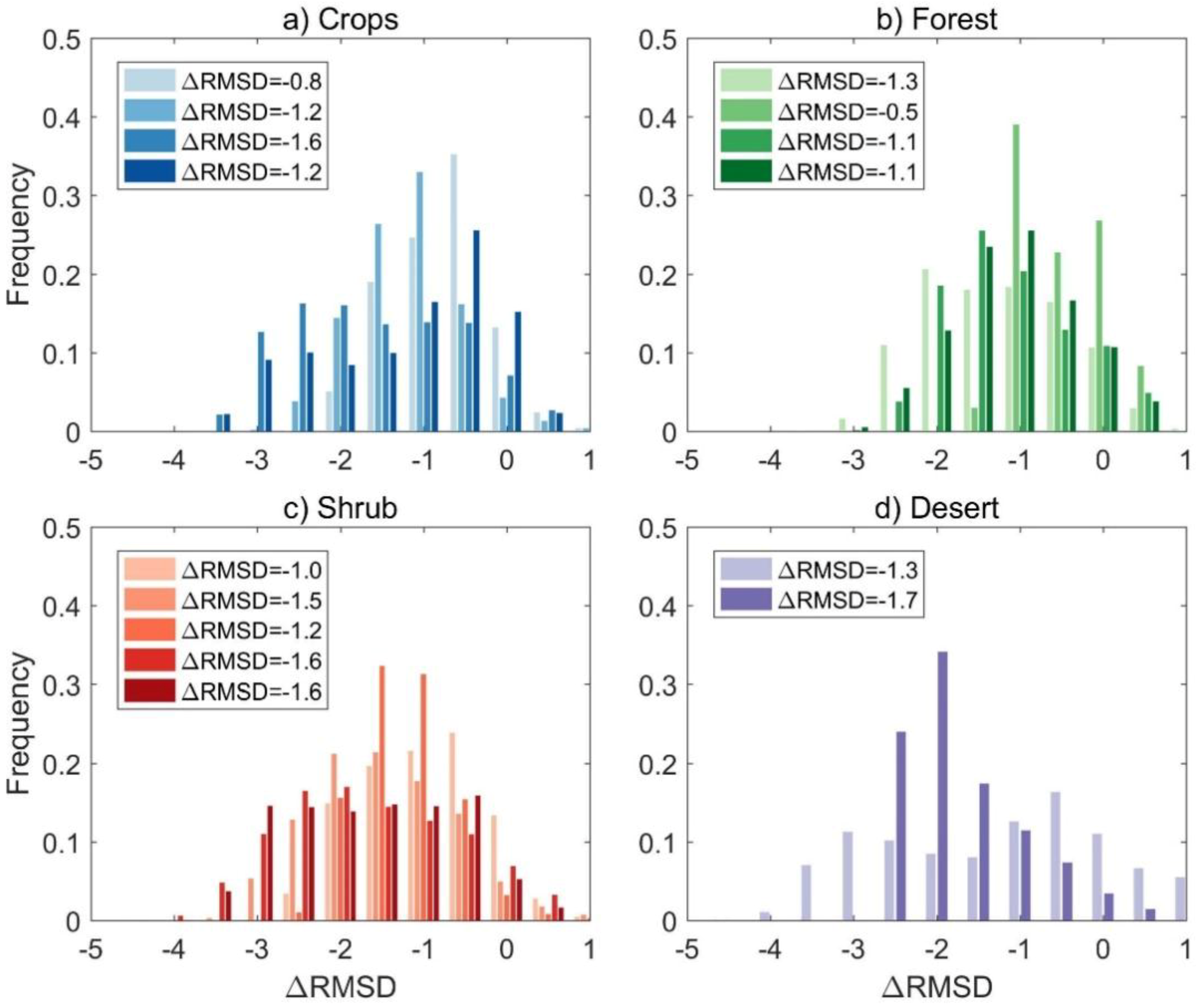
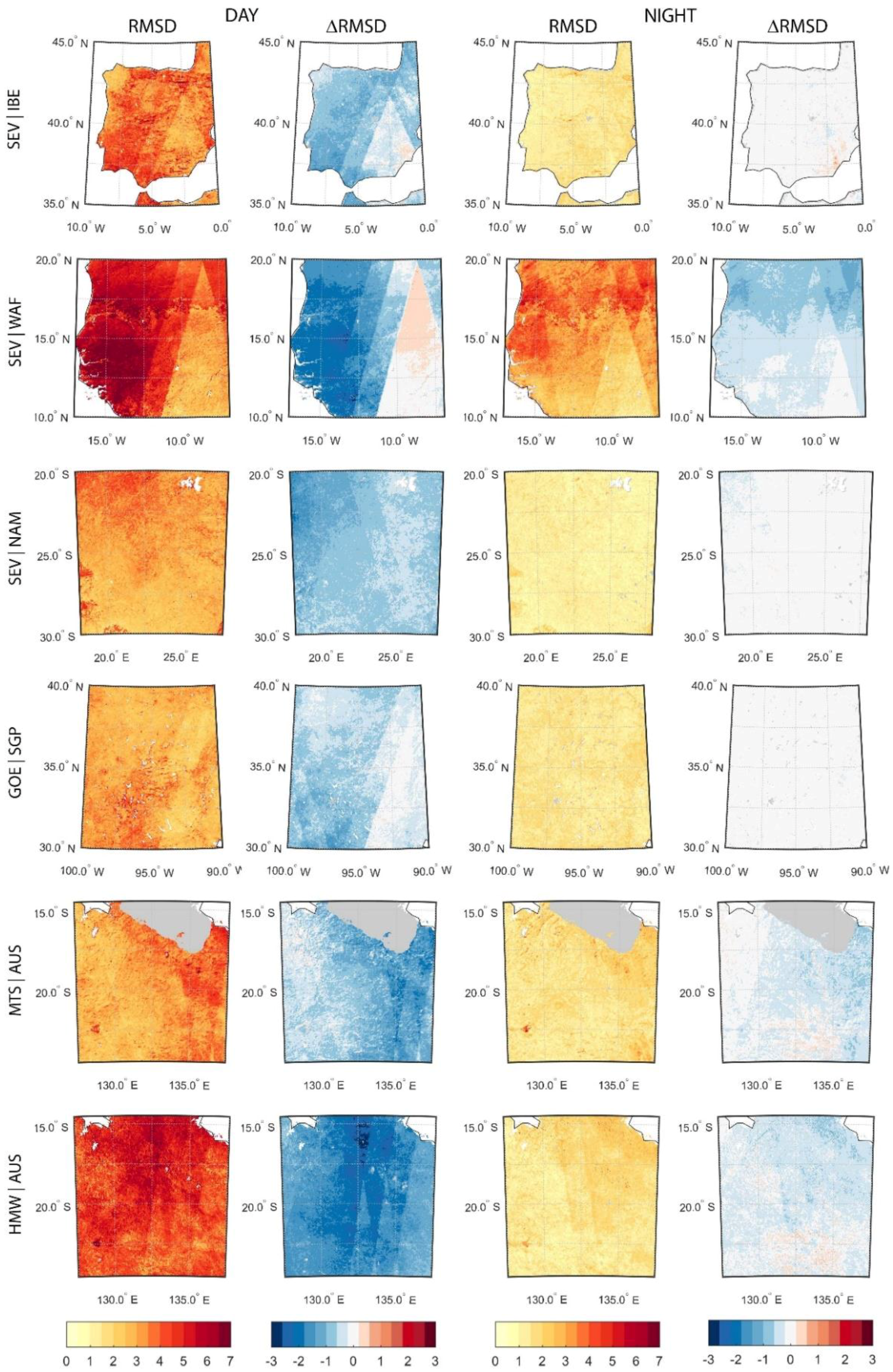
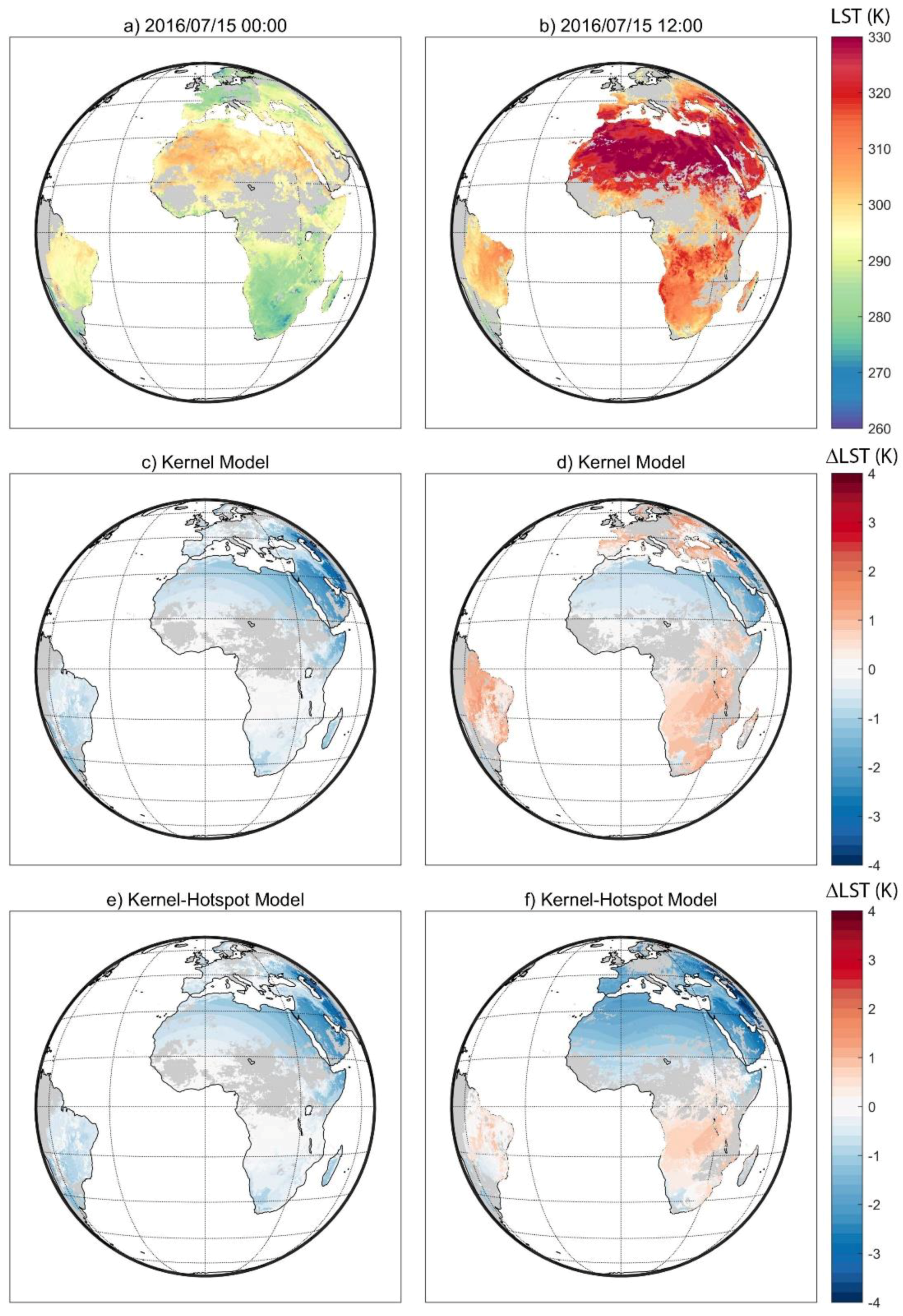
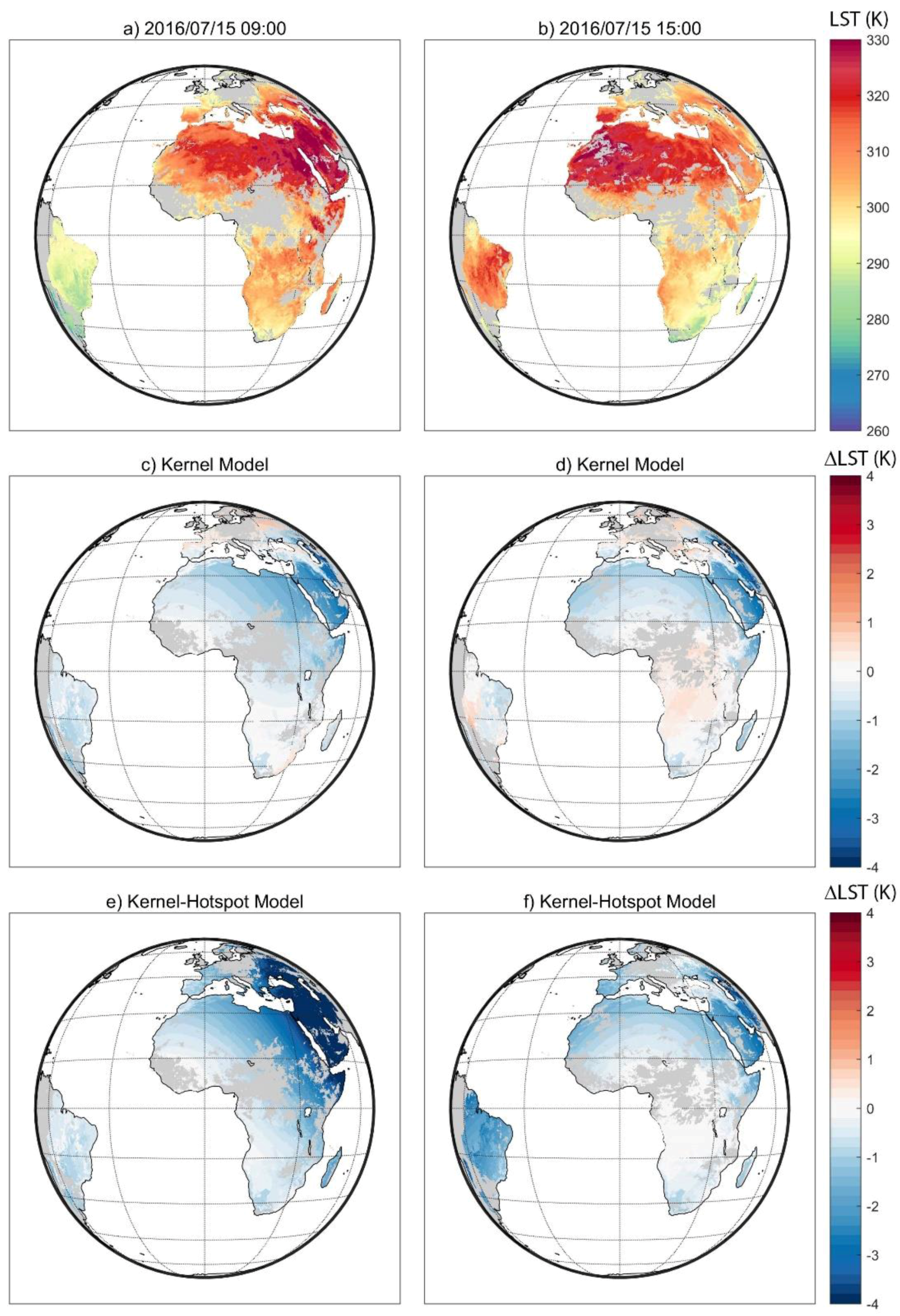
| Cluster | Regression Coefficients | Number of Observations | RMSE of Regression (K) | Bias (K) SEV-MOD | |
|---|---|---|---|---|---|
| α | β | ||||
| C1 | 0.963 | 10.822 | 777,309 | 1.09 | −0.03 |
| C2 | 0.961 | 10.734 | 2,857,306 | 1.00 | 0.39 |
| C3 | 0.931 | 19.337 | 4,215,109 | 1.08 | 0.76 |
| C4 | 0.929 | 19.803 | 3,382,424 | 1.09 | 0.87 |
| F1 | 0.917 | 23.894 | 4,096,421 | 0.98 | 0.20 |
| F2 | 0.948 | 15.256 | 960,060 | 0.94 | −0.10 |
| F3 | 0.948 | 14.609 | 578,180 | 1.22 | 0.35 |
| F4 | 0.929 | 20.332 | 3,177,814 | 0.98 | 0.10 |
| S1 | 0.954 | 13.019 | 626,771 | 1.08 | 0.34 |
| S2 | 0.947 | 14.744 | 6,315,089 | 1.00 | 0.61 |
| S3 | 0.965 | 9.478 | 5,336,698 | 1.05 | 0.35 |
| S4 | 0.899 | 28.847 | 5,724,226 | 1.01 | 0.73 |
| S5 | 0.944 | 15.319 | 6,955,354 | 1.20 | 0.92 |
| D1 | 0.951 | 12.328 | 3,899,579 | 1.30 | 1.82 |
| D2 | 1.023 | −8.363 | 50,020,779 | 1.17 | 1.66 |
© 2018 by the authors. Licensee MDPI, Basel, Switzerland. This article is an open access article distributed under the terms and conditions of the Creative Commons Attribution (CC BY) license (http://creativecommons.org/licenses/by/4.0/).
Share and Cite
Ermida, S.L.; Trigo, I.F.; DaCamara, C.C.; Pires, A.C. A Methodology to Simulate LST Directional Effects Based on Parametric Models and Landscape Properties. Remote Sens. 2018, 10, 1114. https://doi.org/10.3390/rs10071114
Ermida SL, Trigo IF, DaCamara CC, Pires AC. A Methodology to Simulate LST Directional Effects Based on Parametric Models and Landscape Properties. Remote Sensing. 2018; 10(7):1114. https://doi.org/10.3390/rs10071114
Chicago/Turabian StyleErmida, Sofia L., Isabel F. Trigo, Carlos C. DaCamara, and Ana C. Pires. 2018. "A Methodology to Simulate LST Directional Effects Based on Parametric Models and Landscape Properties" Remote Sensing 10, no. 7: 1114. https://doi.org/10.3390/rs10071114






